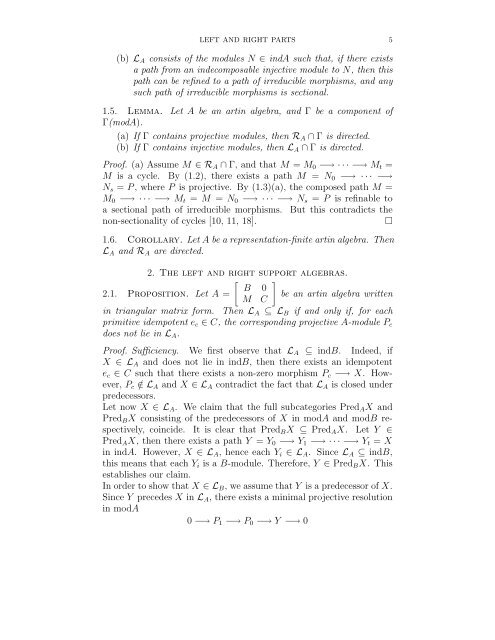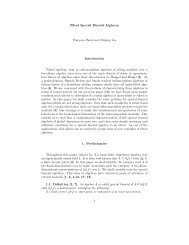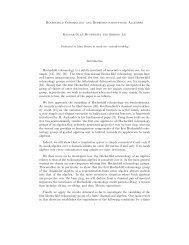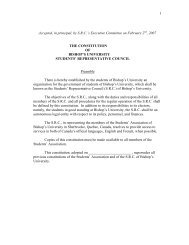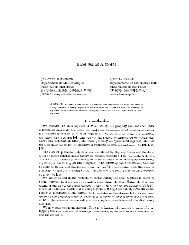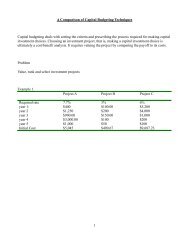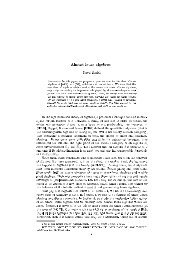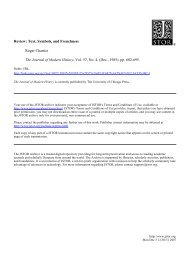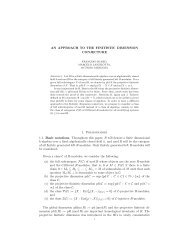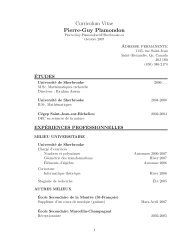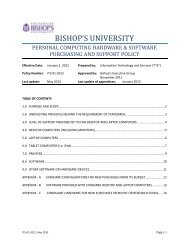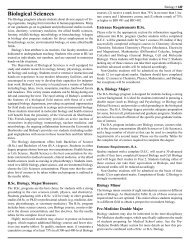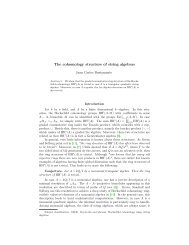The left and the right parts of a module category - Université de ...
The left and the right parts of a module category - Université de ...
The left and the right parts of a module category - Université de ...
Create successful ePaper yourself
Turn your PDF publications into a flip-book with our unique Google optimized e-Paper software.
LEFT AND RIGHT PARTS 5<br />
(b) L A consists <strong>of</strong> <strong>the</strong> <strong>module</strong>s N ∈ indA such that, if <strong>the</strong>re exists<br />
a path from an in<strong>de</strong>composable injective <strong>module</strong> to N, <strong>the</strong>n this<br />
path can be refined to a path <strong>of</strong> irreducible morphisms, <strong>and</strong> any<br />
such path <strong>of</strong> irreducible morphisms is sectional.<br />
1.5. Lemma. Let A be an artin algebra, <strong>and</strong> Γ be a component <strong>of</strong><br />
Γ(modA).<br />
(a) If Γ contains projective <strong>module</strong>s, <strong>the</strong>n R A ∩ Γ is directed.<br />
(b) If Γ contains injective <strong>module</strong>s, <strong>the</strong>n L A ∩ Γ is directed.<br />
Pro<strong>of</strong>. (a) Assume M ∈R A ∩ Γ, <strong>and</strong> that M = M 0 −→ · · · −→ M t =<br />
M is a cycle. By (1.2), <strong>the</strong>re exists a path M = N 0 −→ ··· −→<br />
N s = P ,whereP is projective. By (1.3)(a), <strong>the</strong> composed path M =<br />
M 0 −→ ··· −→ M t = M = N 0 −→ ··· −→ N s = P is refinable to<br />
a sectional path <strong>of</strong> irreducible morphisms. But this contradicts <strong>the</strong><br />
non-sectionality <strong>of</strong> cycles [10, 11, 18].<br />
□<br />
1.6. Corollary. Let A be a representation-finite artin algebra. <strong>The</strong>n<br />
L A <strong>and</strong> R A are directed.<br />
2. <strong>The</strong> <strong>left</strong> <strong>and</strong> <strong>right</strong> support algebras.<br />
[ ]<br />
B 0<br />
2.1. Proposition. Let A =<br />
be an artin algebra written<br />
M C<br />
in triangular matrix form. <strong>The</strong>n L A ⊆L B if <strong>and</strong> only if, for each<br />
primitive i<strong>de</strong>mpotent e c ∈ C, <strong>the</strong> corresponding projective A-<strong>module</strong> P c<br />
does not lie in L A .<br />
Pro<strong>of</strong>. Sufficiency. We first observe that L A ⊆ indB. In<strong>de</strong>ed, if<br />
X ∈L A <strong>and</strong> does not lie in indB, <strong>the</strong>n <strong>the</strong>re exists an i<strong>de</strong>mpotent<br />
e c ∈ C such that <strong>the</strong>re exists a non-zero morphism P c −→ X. However,<br />
P c /∈L A <strong>and</strong> X ∈L A contradict <strong>the</strong> fact that L A is closed un<strong>de</strong>r<br />
pre<strong>de</strong>cessors.<br />
Let now X ∈L A . We claim that <strong>the</strong> full subcategories Pred A X <strong>and</strong><br />
Pred B X consisting <strong>of</strong> <strong>the</strong> pre<strong>de</strong>cessors <strong>of</strong> X in modA <strong>and</strong> modB respectively,<br />
coinci<strong>de</strong>. It is clear that Pred B X ⊆ Pred A X. Let Y ∈<br />
Pred A X, <strong>the</strong>n <strong>the</strong>re exists a path Y = Y 0 −→ Y 1 −→ ··· −→ Y t = X<br />
in indA. However, X ∈L A , hence each Y i ∈L A . Since L A ⊆ indB,<br />
this means that each Y i is a B-<strong>module</strong>. <strong>The</strong>refore, Y ∈ Pred B X.This<br />
establishes our claim.<br />
In or<strong>de</strong>r to show that X ∈L B , we assume that Y is a pre<strong>de</strong>cessor <strong>of</strong> X.<br />
Since Y prece<strong>de</strong>s X in L A , <strong>the</strong>re exists a minimal projective resolution<br />
in modA<br />
0 −→ P 1 −→ P 0 −→ Y −→ 0


